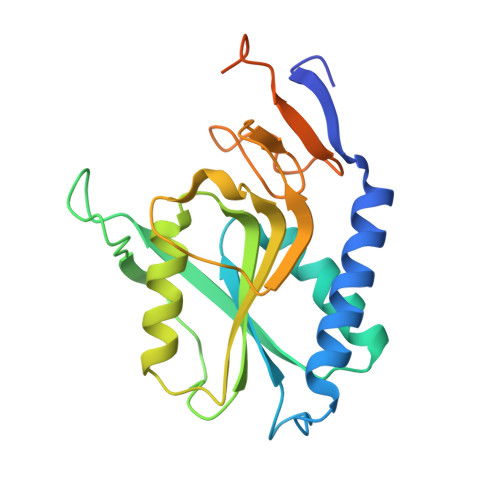Approaching the transition state in the crystal structure of a phosphoribosyltransferase.
Focia, P.J., Craig III, S.P., Eakin, A.E.(1998) Biochemistry 37: 17120-17127
- PubMed: 9860824
- DOI: https://doi.org/10.1021/bi9821465
- Primary Citation of Related Structures:
1TC2 - PubMed Abstract:
Hypoxanthine phosphoribosyltransferase (HPRT) salvages 6-oxopurine bases in the nucleotide metabolic pathway. The 1.8 A crystal structure of an asymmetric dimer of the HPRT from the protozoan parasite Trypanosoma cruzi was determined in a ternary complex with the primary substrate phosphoribosylpyrophosphate (PRPP) and an analogue of the substrate hypoxanthine, revealing both open and closed active site conformations. The ligands are positioned for in-line nucleophilic attack at the PRPP ribose C1' by two metal ions which straddle the pyrophosphate leaving group. The structure provides the first evidence for the involvement of two metal ions in the HPRT-catalyzed reaction, and structural details further suggest the mechanism may proceed via SN2-type chemistry. The closed conformation reveals the structural roles for invariant flexible loop residues Ser103 and Tyr104 and supports a role for the loop in the liberation of pyrophosphate. The pre-transition state structure is valuable for understanding the enzyme mechanism, as well as providing a foundation for antiparasite drug design efforts against T. cruzi, which causes Chagas' disease in humans. Additionally, the structure illuminates the molecular basis of three inherited mutations in the human HPRT leading to Lesch-Nyhan syndrome (D193N) or gout (S103R or S109L), as the homologous residues in the trypanosomal enzyme contribute to the previously unrecognized Mg2+ ion binding site and to the formation of the closed flexible loop, respectively.
Organizational Affiliation:
Laboratory of Molecular Parasitology & Drug Design, School of Pharmacy, University of North Carolina, Chapel Hill 27599-7360, USA.




















